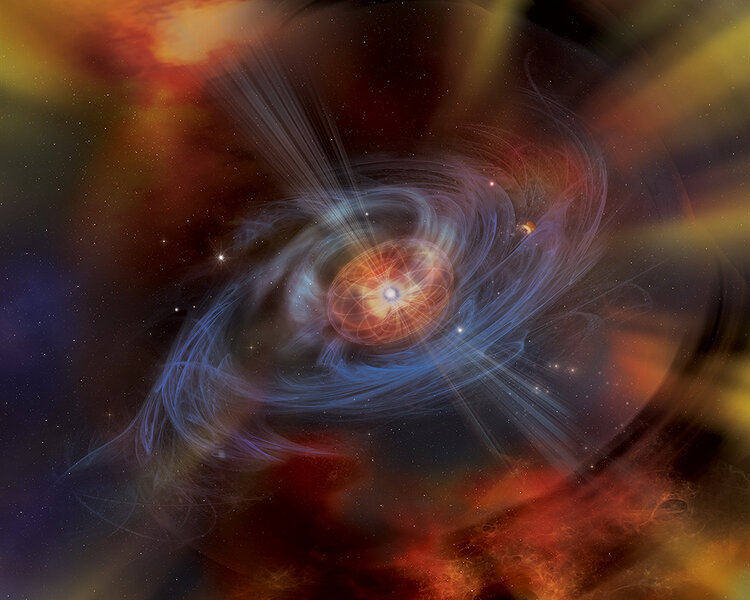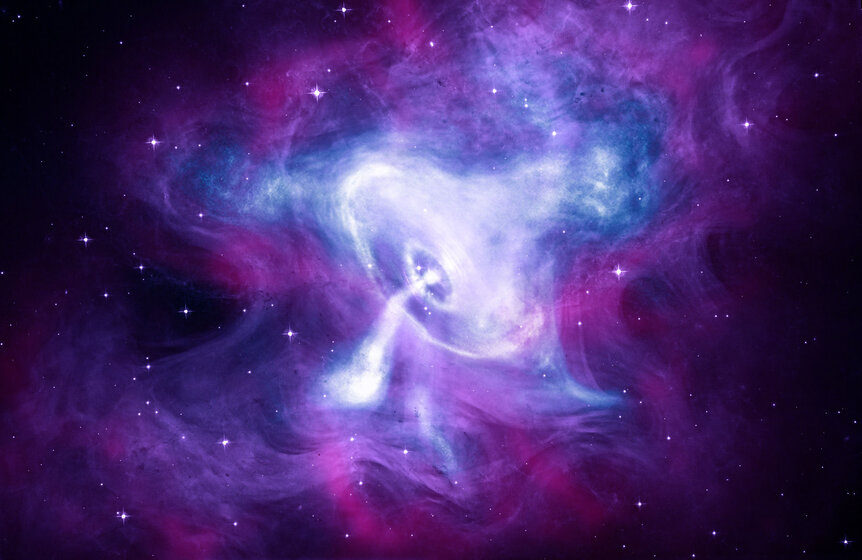Create a free profile to get unlimited access to exclusive videos, sweepstakes, and more!
Is there an angry baby neutron star in the middle of Supernova 1987A?

Where the heck is the neutron star that should be in the middle of the debris from Supernova 1987A?
It's one of the bigger mysteries of modern astronomical times. On the night of February 23/24, 1987 (essentially 34 years ago today, so happy anniversary!) the light from an exploding star reached Earth. Dubbed Supernova 1987A, it came from the Large Magellanic Cloud, a satellite galaxy of the Milky Way just 160,000 light years away. That's close enough that the supernova was visible to the naked eye, and it became one of the most well studied astronomical objects in history*.
The star that blew up was massive, probably about 20 times the mass of the Sun. When a star like that reaches the end of its life it blows a series of powerful winds of gas that surround it. Some tens of thousands of years later the core of the star collapses, setting up an immense explosion that blasts away its outer layers: Supernova.
The collapsing core of a massive star can become either a black hole or an incredibly dense neutron star. In this case, it should've formed the latter.
Newborn neutron stars have powerful magnetic fields and spin rapidly. They blast out beams of high-energy radiation like sweep around like a lighthouse beam, which we see when they pass over us. We get blips of radiation like pulses, so these young neutron stars are called pulsars. They're usually pretty obvious (like a baby screaming on an airplane; the source isn't too tough to spot). But in this case, despite intense searches for over three decades, no neutron star has been found.
However, in the past couple of years evidence is starting to come in. A blob of radio emission was seen recently that could be from the baby neutron star, but it's not 100% certain. Now, astronomers have gone over some archived X-ray observations taken from 2012 – 2014 and find that they too point toward the X-rays coming from the neutron star.
X-rays are a form of light, like the light we see but with far higher energies. It takes powerful events to create them. In a young supernova they could be from the blast wave generated by the expanding debris from the explosion slamming into the gas outside it, or they could be from a seriously strong wave of particles, called the pulsar wind nebula, accelerated by the neutron star's ridiculously fierce magnetic field.
The astronomers looked at the X-ray observations from two space-based observatories, the Chandra X-ray Observatory and NuSTAR. Chandra sees relatively low energy X-rays, and NuSTAR much higher energy ones.
What they found is that the X-ray spectrum — the brightness of the X-rays versus their energy — from the two observatories combined showed that the low-energy X-rays were consistent with the blast wave idea. But if that were the case they'd expect very few high-energy X-rays. However the spectrum clearly shows more high-energy ones than expected.
That leans more toward the idea these X-rays are coming from the pulsar wind, which emits far more high-energy X-rays. The spectrum by itself isn't conclusive. However, we also have a grasp of what's going on physically inside the supernova, and it's much easier to match the spectrum to the physics of a pulsar wind than a blast wave. That's also not conclusive, but it gives a lot more credence to the existence of a neutron star in the middle of all that junk.
There's a way to know better too. All the dense material surrounding the center of the explosion is blocking our view somewhat. Over time that material expands and gets less dense. Like a fog clearing, that should allow more high-energy X-rays through. If we see the higher energy X-rays get brighter, that would strongly favor the pulsar wind model. If instead they get fainter that favors the blast wave idea (which should fade more rapidly over time). Hopefully future NuSTAR observations can settle this question.
We see neutron star pulsars in the centers of many supernova remnants (like the famous Crab Nebula pulsar, or the one in the Vela supernova remnant), and they are an important factor in the shaping and evolution of the rapidly expanding debris from the explosion. The gas around Supernova 1987A, blown by the star before it died, is a bit bizarre, shaped like a huge hourglass with a dense ring in the middle. The actual stellar debris is in the middle of all that, and will slam into this gas over the next few centuries.
If there's a pulsar in there, its vast stores of energy will accelerate that material in the collision like hitting the gas in a car. If we want to understand how this interaction will occur — and oh my we do, since it's the closest such supernova in centuries — then we need to know if there's a neutron star in the middle of all that and what's its doing to add to the chaos. Hopefully soon we'll find out.
*Three years later the newly launched Hubble Space Telescope made SN1987A one of its very first targets; I used those and subsequent observations to get my PhD in astronomy, so this topic is close to me.






























